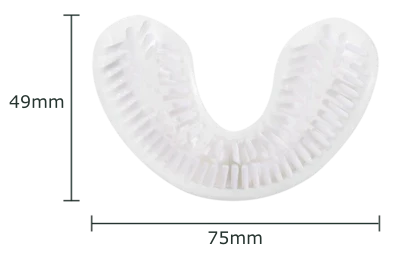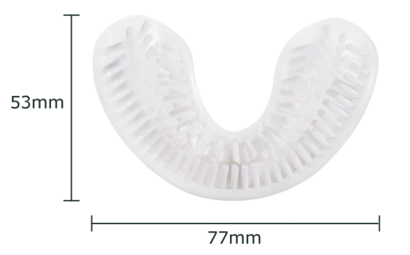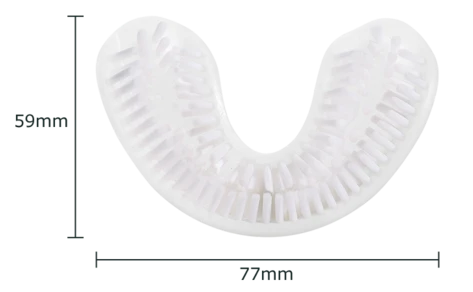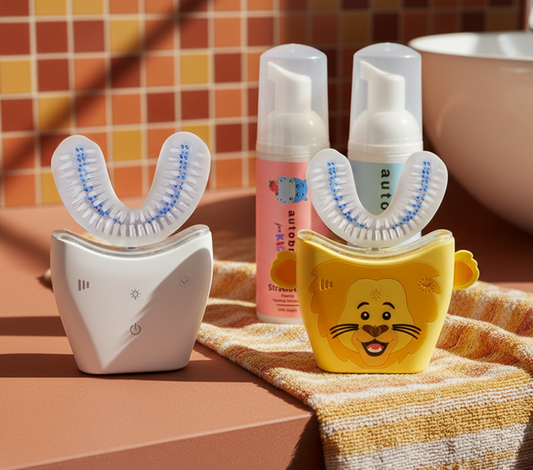
The Journey to ADA Acceptance: A Milestone for autobrush
We are thrilled to announce that autobrush has officially received the ADA (American Dental Association) seal of acceptance! This significant achievement is a testament to our commitment to providing the best oral care solutions.

To give you a deeper insight into this journey, we sat down with our Founder, Head of Growth, and Head of Customer Experience to discuss the challenges, milestones, and the future of autobrush.
Can you tell us about the journey from your initial idea to creating autobrush?
The journey to autobrush started with its parent company, Basis, which has been around for 13 years, evolving from an affiliate company to brand building. Initially, Basis used a hybrid model with dropshipping to learn about brand development, eventually leading to the creation of autobrush during a phase when Basis managed five different brands.
The idea for autobrush emerged after discovering abandoned patents for a whole-mouth toothbrush concept, which sparked our curiosity and obsession with reinventing the toothbrush.
Despite not having a dental background, we became determined to create a new kind of toothbrush, though it proved to be much more challenging than expected. The journey to autobrush involved luck, persistence, and leveraging suppliers to bring the concept to life.
What were the biggest challenges at the start, and how did you overcome them?
As soon as we started selling, we quickly sold a lot, thanks to our high-functioning marketing team. We knew how to leverage the internet, landing pages, and assets to scale a business rapidly.

During that pursuit, it was my first time handling physical inventory in US warehouses and managing the import process. We ordered 5,000 units and sold them out in five days—something we hadn’t planned for or forecasted. I don’t even know if I understood forecasting at that point. We sold them very, very, very fast, much faster than we could have ever imagined.
We were getting a lot of feedback—the good, the bad, and the ugly. It was clear that there was something here, but the product needed to be significantly better. That was the only way to build a real business and a real brand in this space: the product needed to essentially replace the toothbrush. Early on, the materials, vibrations, and techniques were not fully developed.
We learned a lot in that first six months. The biggest challenges were that the product needed to be better, and it was a blessing in disguise because the TAM was there. People recognized that there would be a shift at some point. We got buyers and, with them, valuable feedback. That feedback was a clear light bulb moment, showing us that this could be something if we invested time and effort into making it better, which is what happened.
There’s something about autobrush—a big opportunity and a chance to make a real difference in the world.
We’ve increased capacity, and now we own the machines and have developed and patented the machines that make these products. While we haven’t necessarily vertically integrated, it was clear that to keep scaling, we needed more control over production.
Why was getting the ADA seal important for autobrush?
he biggest issue was natural skepticism from consumers and the dental community, which was justified. However, the ADA seal of acceptance was a crucial step to overcome this skepticism.. New devices should prove themselves, especially if claiming to replace a toothbrush. The only way to do that is through data—proving both safety and efficacy.

The ADA seal represents the highest standard of dental care, and for autobrush to be truly seen as a toothbrush replacement, earning that seal was the only route. The ADA accreditation holds immense weight in the dental community, and it was essential to win over dentists by proving autobrush is a better toothbrush, which we did three times.
What steps did you take to make sure autobrush meets ADA standards?
It was a three-and-a-half-year process. I started by calling clinical sites and faced mostly rejection. One site mentioned I was early in the discovery phase and suggested I talk to and hire Sylvia.
For the next three years, I worked with Sylvia, refining prototypes—adjusting bristle lengths, angles, materials, and testing single versus double arches.

After years of prototyping, we reached a point where we conducted two major ADA clinical trials with a product that had been thoroughly tested.
On the efficacy side, we gained enough confidence to keep investing heavily. The safety side was equally rigorous. We went through 12 Intertek safety tests, and the ADA was just as strict about safety as efficacy. We tested everything—light, sound, vibration, and health, along with GMP requirements at the factories.
In those three and a half years, we completed one pilot study and two large studies designed for both children and adults. We saw great efficacy in both, but especially with kids. For children, anything that requires less technique, covers all teeth, and is fun and faster works well. Adults have better technique with manual toothbrushes, so the difference was smaller, but still significant. It became clear: this is the best toothbrush that’s ever existed.
How did you and the team stay motivated throughout the ADA acceptance process?
It wasn’t easy. This is not a venture capital business. We have no debt. It’s all self-funded and completely bootstrapped. This business is financed by me, with significant investment of both financial and emotional capital. What I believe is true is that if something is worth doing, it’s worth doing. When it’s worth doing, it’s easy to stay focused and committed. It’s something to be proud of, and it’s an admirable endeavor. It’s the first time anything like this has been done. We have steadfast followers now, but they wouldn’t exist without autobrush. The evidence is in the reviews—whether they’re improving or not. Those trends reflect how well things are going and align with the story of where we’re headed.
If you have an ambitious, entrepreneurial spirit, this is the place for you. Over time, you end up with a team that doesn’t operate within the constraints of a legacy business or something mundane. These people are invested in the vision and have a vivid sense of how it will turn out. This energy resonates, attracting the right people and filtering out those who don’t align with our goals.
What does the ADA acceptance mean for autobrush and its users?
For those who only buy ADA-approved products, it signals that a product is safe and effective. For current or past consumers, it reinforces that autobrush is committed to improvement. It’s the ultimate signal of trust, safety, and efficacy.
If I had 30 seconds with any skeptical consumer, I’d explain why autobrush is unique and proven effective. I believe it would be a compelling argument that it’s better and faster than what they’re currently using twice a day.
Any company that has gone through what we did to achieve ADA approval shows commitment that should be as valued as the ADA itself. As long as I’m in control, the product will continue to improve, catering to a wide range of users—kids, adults, and people with disabilities.
So what does it mean? It's borderline everything. It’s a signal of our competency, that the product works and is safe, and an internal affirmation that we’re serious about this mission. It’s another step in autobrush’s journey of firsts. The motivation comes from a team that continually pushes boundaries and expects excellence, creating a ripple effect that fosters internal excellence.
What’s next for autobrush now that you’ve received the ADA acceptance?
More clinicals for sure. We have the next three lined up, with the big focus now being on partnering with dentists. We had plenty of dentist support for autobrush before, which was great, but there was always natural skepticism, which is fair. Now, we aim to build authority by working closely with dentists, getting feedback, and improving the product to meet their needs.
We need to understand the consumer’s needs from a dental perspective. We have data on our actual consumers, but little insight into what happens in the dental chairs or offices. What do dentists need? How can we make the product more affordable? We need to work on the economics and make it more accessible.
Next steps include conducting more clinicals to keep proving our product and never getting complacent. With dedicated help and one-on-one contact with dentists, we aim to enhance autobrush. The B2B aspect of autobrush is new and expanding beyond small retail ventures.
We’re not just a kids’ brand anymore. This positioning shift affects the physical experience of autobrush and how we cater to those we serve. Everything is changing in a meaningful way.
How did you first market autobrush, and how has your strategy evolved?
In the beginning, autobrush was actually for adults only. So, we got a bunch of comments on our products asking if we can make this for kids. We were really set just focusing on pointing out that this is a new technology.

This is some innovation where there's previously been absolutely none. And that kind of redirected our focus to this is a toothbrush that everyone can use. Let's make sure that we have that ability to spread autobrush everywhere. Since the initial launch of autobrush, we've done so much product innovation and so much work towards proving that it truly is the best that sometimes it's really hard for us to not just talk about its efficacy and how amazing it is in that regard. But we are constantly trying to pinpoint different ways and the reasons that autobrush can be amazing in everyone's lives, because it is truly now a brush for the whole family rather than just the adults in their life.
How important is innovation for autobrush’s growth?
Extremely. The better the brush works, the happier our customers are and the more we get to brag that it truly is the best option
What impact do you expect the ADA acceptance to have on autobrush’s growth?
Hopefully it gives peace of mind that our brushes are safe and effective, allowing dentists and regular people to know that we are what we say we are. And hopefully more dentists will want to partner with us
What challenges did you face while growing the brand and pursuing ADA acceptance, and how did you overcome them?
Doubt. Rather than prove in our studies that we can keep up with a regular toothbrush, we had to prove we were BETTER than a toothbrush, and against someone brushing for 2 minutes rather than their normal routine.
Doubt that we would work from customers.
Both solved by just doing clinicals at whatever instructions thrown our way. We stand behind our brush.
What are your plans for scaling autobrush now that it has ADA acceptance?
Screaming it from the rooftop, putting it in so many ads, putting the logo in all the places. Just making sure it’s visible then keeping on the mission to have everyone know autobrush is simply the best.
How do you use feedback from customers to help shape autobrush’s future?
We use every point of feedback to continuously iterate upon many of the decisions we make, from pursuing new clinical studies, to developing new educational content for customers, to improving user experiences on existing products, and to creating new products. The #1 reason our product exists today is because of customer feedback.
Can you share a story where customer feedback helped improve autobrush?
The most vocal audience is the community of parents with kids that have SPD, Autism, and ADHD. That audience has driven a lot of meaningful changes over the years. One that comes to mind is being able to turn off the music on our pro brushes after we received feedback from parents with kids that have sensory sensitivities.
Pricing feedback also pushed us to introduce more affordable options, which led to the development of our manual and sonic brushes.

This has allowed us to better meet the needs of a wider range of families while maintaining the quality and effectiveness they expect.
How do you address customer concerns about product safety and efficacy?
Taken seriously. We are always transparent about our clinical studies. There are many knockoffs in the space that use an inferior brush head made of silicone. Unfortunately, this has driven negative perceptions about U-shaped toothbrushes, so it’s definitely something we’re working adamantly against to help improve customer education.
Beyond just clinical studies, we’ve done extensive additional testing to ensure that the products our customers use today are as safe as possible. From testing the lights on our pro brush to confirm their safety, to conducting audio decibel testing to ensure the music isn’t too loud, we prioritize safety at every step.
How did customer feedback contribute to achieving ADA acceptance?
They painted a reality that we were going to continuously face doubts about whether or not our product worked or was safe, unless we aggressively pursued the seal. It wasn’t quick or overnight—there was a lot of rigor involved. Redefining a convention isn’t easy, but ADA acceptance is the gold standard for dental products and drives both consumer and dentist trust. This seal solidifies our commitment to safety, quality, and effectiveness, helping us reassure customers and professionals alike that our product meets the highest standards in oral care.
How excited are you to communicate the benefits of ADA acceptance to customers?
Beyond excited. I actually have a list of comments I plan to reply to first, and I look forward to sharing this major news with every customer everywhere. Most of all, I’m looking forward to sharing it with our existing customers, because they believed in our brand, and I can’t wait for them to hear about it.

Beyond that, there’s just immense pride. I joined autobrush in 2020 and have been with the company for 4.5 years. From the very beginning, we were always planning to pursue ADA acceptance. Now that it’s finally a reality, it’s incredibly fulfilling to see that hard work come to fruition. Get a glimpse into our amazing journey to ADA here!
The journey to ADA acceptance has been a remarkable one for autobrush. This achievement marks a new chapter in our mission to revolutionize oral care. We’re excited to continue this journey with the trust and support of our valued customers. Stay tuned for more updates and innovations from autobrush!















